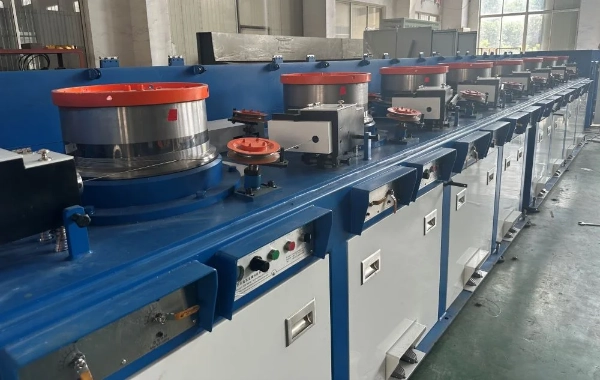- This topic is empty.
-
AuthorPosts
-
2025-04-22 at 4:29 pm #9348
In the realm of industrial metal fabrication and manufacturing, efficiency, precision, and consistency are paramount. One essential component that directly affects welding performance is the quality and consistency of welding wire. With increasing demand for high-performance welding operations, the adoption of CO2 welding wire drawing machines has become increasingly prevalent in modern production facilities. In this blog post, as a high performance steel wire drawing machine exporter, Yifam will share the advantages of using automatic CO2 welding wire drawing machine designed to increase the production efficiency of CO2 welding wire.
Automatic CO2 Welding Wire Drawing Machine Advantages
1. Enhanced Wire Quality and Dimensional Precision
Automatic CO2 welding wire drawing machines are engineered to produce wires with extremely tight tolerances. This level of precision ensures consistent wire diameter, which is critical for stable arc characteristics in gas metal arc welding (GMAW) processes, particularly CO2 welding.
– Uniform Diameter Control: These machines integrate advanced die configurations and automated feedback systems to maintain consistent pressure and tension throughout the drawing process. This minimizes variations in wire diameter, reducing spatter and improving weld bead appearance.
– Surface Finish Improvement: By incorporating multiple reduction passes and optional cleaning or polishing modules, these machines yield wires with smoother surfaces. A superior surface finish minimizes friction within the welding torch liner and reduces wear and tear on contact tips.
2. Increased Production Efficiency
One of the most prominent advantages of automatic wire drawing machines is their ability to operate continuously with minimal human intervention, leading to significant improvements in production throughput.
– High-Speed Drawing: Modern machines are capable of drawing wire at high speeds (sometimes exceeding 20 m/s), significantly reducing the production time per spool or coil of wire.
– Continuous Operation: Many systems support coil-to-coil or rod-to-coil operations with automatic feeding and unloading, allowing for 24/7 operation with minimal downtime.
– Automation Integration: These machines can be integrated into fully automated production lines, including pre-processing (descaling, pickling) and post-processing (copper coating, packaging), which further streamlines manufacturing.
3. Consistency and Repeatability
Repeatability is crucial in industrial welding, especially when dealing with large-scale fabrication where each weld must meet stringent standards.
– Automated Parameter Control: These machines feature programmable logic controllers (PLCs) and human-machine interface (HMI) panels that allow for the storage and retrieval of drawing parameters. This ensures consistent process settings across multiple production runs.
– Sensor Feedback Loops: Real-time sensors monitor wire tension, diameter, speed, and die wear, allowing the system to make on-the-fly adjustments to maintain consistent product quality.
– Reduced Human Error: Automation eliminates the variability introduced by manual intervention, ensuring that each batch of wire meets the same technical specifications.

4. Reduced Operational Costs
While the initial capital investment for an automatic CO2 welding wire drawing machine may be substantial, the long-term cost savings make it a highly cost-effective solution.
– Lower Labor Costs: Automation reduces the need for skilled labor during the drawing process. A single operator can monitor multiple machines, decreasing the labor cost per unit of output.
– Minimized Scrap Rate: Precision controls result in fewer off-spec products, thereby reducing waste and material loss.
– Energy Efficiency: Modern machines are designed with energy-saving drives and optimized motor systems. Some models include regenerative braking systems that recapture energy during deceleration phases.
5. Enhanced Safety
The wire drawing process involves significant mechanical forces and potential hazards such as high-speed moving parts and wire recoil. Automation improves workplace safety by reducing human interaction with dangerous machine elements.
– Enclosed Systems: Most automatic wire drawing machines are built with safety enclosures, interlocked doors, and emergency stop features to protect operators.
– Remote Monitoring and Diagnostics: Operators can monitor machine performance from a safe distance and receive alerts on potential issues, reducing the need to physically inspect hazardous areas.
– Automatic Lubrication and Cooling: Proper lubrication and die cooling are critical to maintaining safe operating temperatures and extending equipment life. Automation ensures these processes are carried out reliably and consistently.
6. Flexibility and Scalability
Automatic CO2 wire drawing machines can be tailored to produce various wire diameters and materials, providing flexibility to meet changing production demands.
– Modular Design: Machines often come with interchangeable modules for different drawing dies, pre-treatment systems, or finishing options (e.g., copper coating or baking).
– Multi-Pass Drawing Capabilities: Whether producing wire for thin sheet welding or structural applications, the ability to adjust the number of drawing passes allows for production versatility.
– Customization for Alloys: Machines can be configured to draw not only mild steel wires but also stainless steel, aluminum, and special alloy wires used in niche welding applications.
7. Improved Environmental Compliance
Modern automatic wire drawing machines are designed with environmental considerations in mind, helping manufacturers comply with increasingly stringent regulations.
– Closed-Loop Lubrication Systems: These systems reduce lubricant consumption and prevent spills, lowering environmental contamination and operational costs.
– Dust and Fume Extraction: Integrated filtration systems capture metal dust and airborne particles generated during drawing, improving air quality in the facility.
– Recyclability of Waste Materials: Scraps and shavings are often collected in designated bins and can be recycled, contributing to a sustainable production model.
Conclusion
The adoption of automatic CO2 welding wire drawing machines marks a significant leap forward in the production of high-quality welding wire. These machines deliver unmatched advantages in terms of precision, efficiency, safety, and adaptability. As manufacturers continue to embrace automation and digitalization, the integration of such advanced machinery not only boosts competitiveness but also ensures sustainable and consistent production. Whether you're scaling up operations or seeking to optimize existing workflows, investing in an automatic wire drawing machine is a strategically sound decision that delivers long-term dividends.
http://www.yifam.com
Yifam -
AuthorPosts
- You must be logged in to reply to this topic.